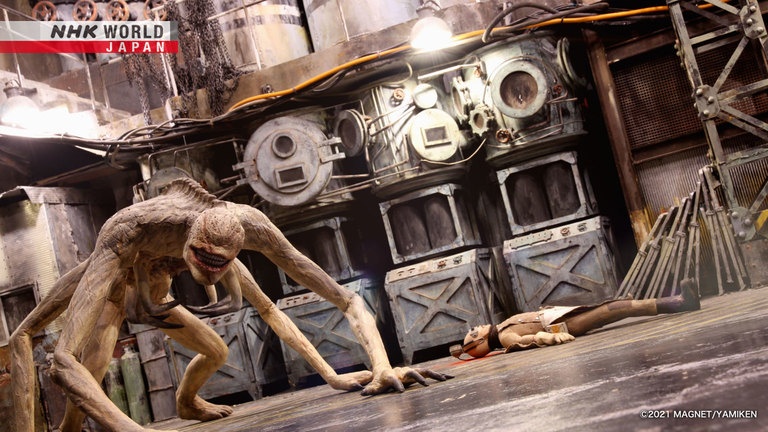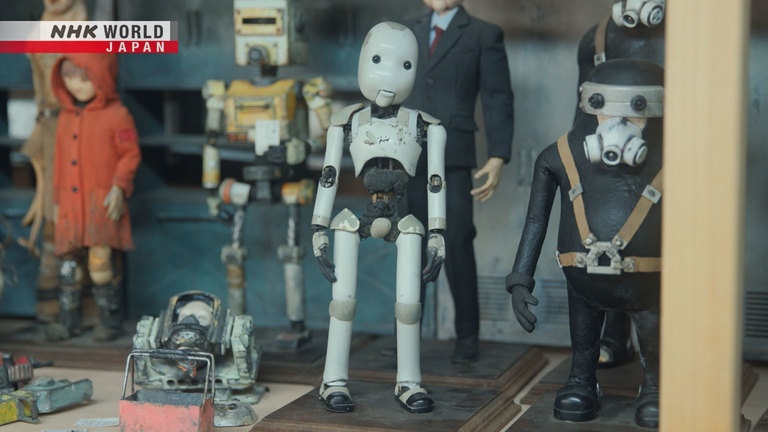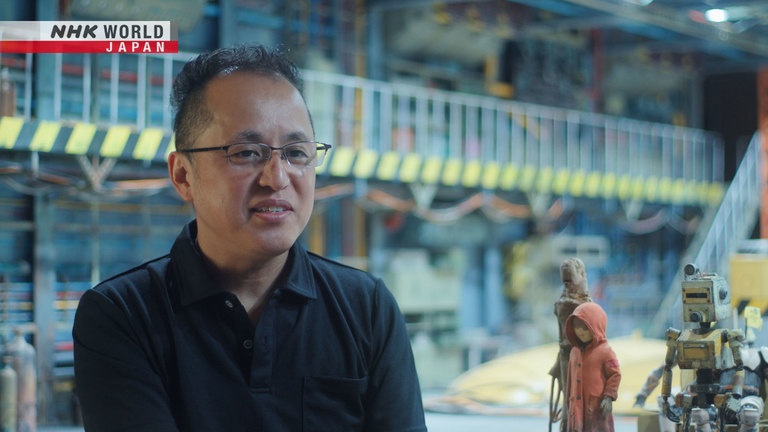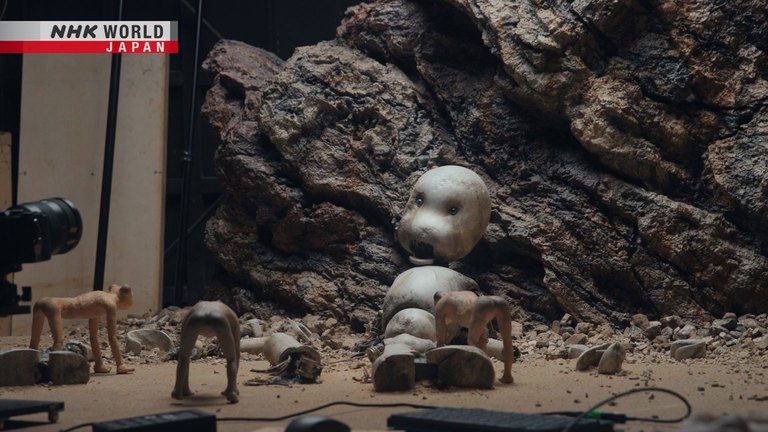FEATURED ANIMATION ARTIST Hori Takahide
ANIME MANGA EXPLOSION gives you a special look into the secrets of the world's biggest anime and manga series. In this episode, the spotlight is on Hori Takahide, director of the sci-fi feature film JUNK HEAD. How did Hori create a critically acclaimed stop-motion animation on his first try? Go behind the scenes of his Hollywood-like action scenes and detailed set design and find out what drives Hori's creativity. Plus, get a sneak peek at JUNK WORLD, his new work currently in production.




Transcript
ANIME MANGA
EXPLOSION.
Here we go!
3!
2!
1!
Zero!
The sci-fi feature "JUNK HEAD" garnered international attention after its 2021 release.
The stop-motion animation depicts a mysterious, underground world.
This is director Hori Takahide's first feature, which he started when he was 38.
Hori began production alone with only self-taught techniques.
It took him seven years to complete this 1 hour and 39-minute film.
The film received high acclaim from international audiences.
A US film website praised Hori's work as "a marvel of imagination, scope, and detail."
A British science fiction magazine loved the "cute and creepy dystopian tale" and Hori's unique vision.
Even Academy Award-winning director Guillermo del Toro posted his praises on social media.
A One-man band work of deranged brilliance!
Monumental will and imagination at work.
Where does "one-man band" Hori's creativity come from?
I feel I can do anything
if I work hard enough.
My skills may not be the best,
but if I feel something is possible,
I can keep going.
Puppetry and stop-motion with the realism of live-action!
Elaborate sets with incredible attention to detail!
Action scenes to rival Hollywood blockbusters!
Let's dive into the creative secrets of Hori Takahide!
Hori's studio is located in a renovated warehouse.
Almost all of "JUNK HEAD" was created here, from puppet and set creation to filming and editing.
Pod will drop in.
10.
"JUNK HEAD" takes place in the fictitious year 2285, AG, and starts from an underground research base on Earth.
The main character takes a pod to investigate signs of artificial life underground.
Hmm?
Something is falling your way.
Something?
I dunno. Maybe shoot it.
Just in case?
We're back!
Welcome back.
Anything good?
Doctor, look at this!
What is it?
Doctor, what in the world...?
I do believe it is human.
Doctor, what are humans?
Our ancestors.
In a way, they're gods.
This is God...
Okay, now just calm down
and have a look.
Is this... me?
I was inspired by huge,
underground spaces.
Hori depicts the underground world with a dreadful atmosphere.
The protagonist is Parton, an underground investigator.
To survive a virus, humans replaced their bodies with robots, leaving only the head.
Underground, Parton encounters Marigans, artificial life forms created by humans long ago.
Marigans have mutated to be capable of various functions and forms, from human-like figures to dangerous creatures.
My work is how I see humanity evolving.
Cloning humans isn't allowed today.
But it will happen eventually.
I believe the world I created
will become reality,
be it a hundred
or a thousand years from now.
Since he was a teen, Hori has immersed himself in various forms of creation.
After graduating high school, he pursued a career as an artist while working part-time.
His creative work included paintings, sculptures, and puppets.
However, Hori couldn't make a living off just his creative endeavors, so in his late 20s,
he began to earn money by creating murals for commercial facilities and painting objects to look aged.
But a certain animated work inspired Hori to become a filmmaker.
That was the short film, "The voices of a distant star."
The 25-minute animation was directed, written, drawn, and edited by Shinkai Makoto.
I was shocked a single person
could make a commercially-viable film.
At the time, I didn't feel successful
with what I was doing.
I wanted to create a major work in film,
an all-encompassing medium.
Hori shifted his focus toward creating a stop-motion film.
In stop-motion, puppets, and other objects are photographed then connected to form moving images.
It was a format where I could use
all my acquired techniques.
I just needed to buy a camera
and start shooting.
Making a film seemed easy.
While working in interior construction, Hori created puppets and sets, and taught himself photography.
The first work he completed was a 30-minute film that eventually became the full-length "JUNK HEAD."
Hori published the video online to great acclaim.
A company decided to fund the project, and production on the film began.
Hori quit his other jobs, hired three primary staff, several temporary workers,
and focused on production.
He took on all major roles, including scriptwriting, cinematography, and art production.
The finished work was 1 hour and 39 minutes long.
The creator pursued realistic visual expression - something hard to achieve with stop-motion.
Here's a scene where a ferocious Marigan attacks Parton.
Beyond the textured puppets and set, Hori vividly expressed the flowing blood.
The story and characters are created
to fit the stop-motion format.
Cotton is used to portray
water and clouds.
Figures are made with clay.
I didn't like the typical format.
I aimed for realism.
I wanted the characters
to feel like living creatures.
That's why I included scenes
where they bleed and get injured.
Hori also focused on realistic movement for the puppets.
These are puppets used in the production.
Hori's attention to detail is hidden inside.
The skeleton of each puppet is made with metal.
The skeletons have multiple joints.
This creature has over 90.
This allows for detailed movement, all the way down to the fingers.
Hori's puppets could move and pose like real living things.
He even pursued realism in the actual character performances.
Guess I'll try shotting it.
Take this scene, where a character grabs a weapon and prepares to shoot.
Guess I'll try shooting it.
Hori films himself and staff members performing the character movements.
Then, frame by frame, he moves the puppets to match the video.
To make the movement even smoother, Hori animates at 24 frames per second, more than typical stop-motion.
He repeated this process for nearly every scene, capturing comical and detailed movements for his puppets.
I can move robots and creatures
just as I imagine them.
When the characters start to move,
it's like they really come to life.
That's the fun part.
Hori's pursuit of realism can also be found in his sets.
This is Valve Village, an important setting that controls the piping system.
What're you doing?!
Hurry up and close #15!
Yes, ma'am!
To create this scene...
Hori built a colossal set 2.5 meters wide and 5 meters deep.
He used electric cables from a waste site and PVC pipes he purchased, and painted the set himself.
The set's detailed construction is another example of Hori's pursuit of realism.
The valve operating panels, trash cans, and gas cylinders are only a few centimeters tall but are meticulously crafted.
The attention to detail was so the quality of the images would be the same for dynamic long shots and close-ups.
Aging a set is like painting.
I add rust or damage objects.
I even imagine how they got damaged,
like getting hit by a vehicle.
It's beautiful when rust and damage
are both visible and in the right place.
The result is like a painting.
Hori painted rust, scratches, and other stains across the set, including the tools.
Purposeful staining adds another layer of realism.
It took Hori six months to complete the massive Valve Village set.
It was nothing compared to
interior construction.
I built a full-sized city
for a theme park.
This was just a smaller version.
Easy.
Here's a scene that takes place on the large set Hori built.
What're you doing?!
Hurry up and close #15!
Yes, ma'am!
Step on it!
Yes'm!!
At this rate the pipe's
not gonna hold.
If that pipe bursts,
this whole place'll be blown away!
We have no other choice.
Divert some of #8's pressure into #9 and #12!
Here we go!
3!
2!
1!
Zero!
That was close.
Man, though, pipe #8 is really acting up lately.
Well, this is an old facility.
Outta the way!
Sheesh.
This is why men are just useless!
Oh no, oh no.
The devil was whispering to me again.
But when it's so comfy like this...
I get...
so slee...
py...
Hm?
Earthquake?
What's heaven like?
Some of the best highlights of "JUNK HEAD" are the midair, slow-motion action scenes.
Here, Parton's companions engage in a deadly fight with a ferocious creature.
Hori aimed to create Hollywood-level action.
I watched Hollywood action scenes
frame by frame.
A lot of action is done in editing.
A lot of quick cuts from different angles.
I learned camerawork is a key component
for Hollywood-style action.
Hori used the technique he learned from Hollywood movies: quick cuts filmed from different angles.
Deciding the camera position proved to be complicated.
In this scene, the main character is stuck on the wall while fighting a creature on the ground.
Hori needed a high angle for the hero's perspective and a low angle for the creature.
One camera needed to be placed below the creature lying on the ground for an effective shot.
- Will the camera fit?
- I think so.
Hori dismantled the floor of the set to make room for the camera.
This let him shoot from below the creature.
Hori emphasized the tension of the vertical battle through effective camerawork.
No matter how interesting
the story may be,
if it doesn't look good on screen,
it will be boring.
That's not film.
For the aerial battle, Hori used a stick-like device to hold the puppets in midair.
He erased unnecessary parts with editing software and created an action scene reminiscent of Hollywood.
Creating the slow-motion effect took a lot of time.
In this scene, one of the hero's companions kicks the creature away.
At normal speed, the puppets move about four centimeters per frame.
For this shot, Hori went with five millimeters.
The smooth camera movement in each cut heightens the tension of the action.
At first, however, Hori's camerawork left much to be desired.
He says he'll never forget the bitter experience of creating the 30-minute short.
Piecing together still images
felt cold and industrial.
Like it was made in a factory.
It was so boring
I slept for three days in shock.
Stop-motion is a series of still images, which can become monotonous without ingenuity.
Through trial and error, Hori discovered a trick to use while editing.
This is a video of the images connected as they are.
Hori uses editing software to slightly adjust each cut.
This creates an effect similar to camera shake.
It made it feel handmade.
Time flows through the story.
My mind is able to replace
the images with live-action.
Hori is at his best during action scenes.
The fast bullets are worthless.
Guess we have no choice...
Is everything okay?
Yeah. We're just getting started.
But he's so big.
Okay, let's do this.
Leave the rest to us.
Okay.
Here we go!
C'mon!
A-
Alexander, watch out!
Alexander!
It took Hori seven years of hard work to finish "JUNK HEAD," which went on to win numerous awards across the globe.
For Hori, the film was life-changing.
Once I decided to become an artist,
I put everything I had into creation.
I lived 40 years without any
clear direction or success.
But this work showed me
a place I can truly feel alive
It changed my life.
Hori is already at work on his next big project.
They have big hands,
so make the fingers thicker.
Yes.
It's all wrong. Do it again.
Hori and his staff of six are working exclusively on a new production titled "JUNK WORLD," the sequel to "JUNK HEAD."
Hori created a story that takes place 1,000 years before "JUNK HEAD."
I originally conceived "JUNK HEAD"
as a trilogy.
Characters go to a different dimension.
There are living things that are
neither human nor Marigan.
Compared to my previous work...
it's about four to five-times larger.
The film is aiming for a theatrical release in 2025.
Here is a freshly completed scene from "JUNK WORLD."
I-I-I am a God.
Kneel and bow your heads.
Worship me.
If you do,
I will give you wisdom.
What motivates you to make films?
I believe I've created a new genre
of stop-motion animation.
A lot of Hollywood movies cost
over 100 million dollars to make.
I've been told my films are more
interesting, even with a lower budget.
The thought I can take on Hollywood
keeps me going.